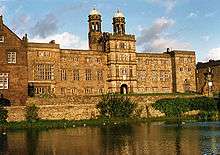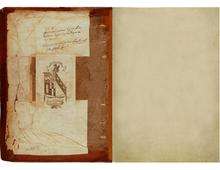Thomas Weld (of Lulworth)
Thomas Bartholomew Weld (1750-1810), known as Thomas Weld of Lulworth Castle, was a member of the English Catholic gentry, landowner, philanthropist and bibliophile.[1] He proved to be a great benefactor of the Society of Jesus in England in their educational and pastoral endeavours. He was also a benefactor to other Roman Catholic religious and clergy. He was a personal friend of King George III.[2] His sister-in-law was Maria Fitzherbert. After the French Revolution he hosted refugee remnants of the French royal family at his castle. He was the builder, in 1786, of the first Roman Catholic place of worship in England after the Protestant reformation.
Thomas Bartholomew Weld | |
|---|---|
| Born | 24 August 1750 |
| Died | 1810 (aged 59–60) |
| Burial place | Lulworth Castle Chapel, Purbeck District, Dorset |
| Nationality | British |
| Occupation | Landowner, philanthropist and book collector |
| Known for | Rare books collection, Philanthropy: Stonyhurst College, Stonyhurst Saint Mary's Hall |
| Family | Thomas Weld, Weld-Blundell family, Maria Fitzherbert |

Life
Thomas Weld was born into an old recusant family descended from Sir Humphrey Weld, who was elected Lord Mayor of London in 1608, the fourth son of Edward Weld and Dame Mary Teresa, née Vaughan. Two of his older brothers and his parents both died when he was a child.[3] At age six in 1761, on the death of his father, Weld inherited the Stonyhurst estate in Lancashire from his father's cousin, Maria Shireburn (died 1754), widow of Thomas Howard, 8th Duke of Norfolk (1683-1732).[4]
After home schooling, he was sent to the English Jesuit school at Watten and Bruges in Northern France and Austrian Netherlands. He was reputedly not a distinguished scholar, due to repeated disruptions of his schooling from local political turmoil, but he developed an attachment to the community he met there and it fostered his lasting interest in education.[2] On return to England, he married Mary Massey, née Stanley. They had six daughters and nine sons, the eldest of whom was also Thomas, who after being widowed and left with a daughter, entered the church and rose to the status of cardinal.[5]
His older brother, Edward, died in a horse-riding accident three months after his marriage in July 1775 and the family inheritance fell to Thomas. His brother's widow, Maria née Smythe, married Thomas Fitzherbert who also died prematurely in 1781. She was introduced to the Prince of Wales, the future George IV and they contracted a morganatic marriage in 1785, which was repudiated both by the king and the Privy Council of England.[2]
Bibliophile landowner

As the new owner of Lulworth Castle and the Lulworth Estate, Thomas Weld, who until then had been living with his wife in Britwell in Oxfordshire, refurbished the interiors of the "castle" in the then fashionable Adam style. It is said the most sumptuous was the library indicating he was a keen bibliophile who possessed a number of exceptional rarities in his collection, including the Luttrell Psalter, the Bedford Book of Hours, bought from Margaret Bentinck, Duchess of Portland in 1786 and Shakespeare's history textbook, Holinshed's Chronicles 1587 2nd edition.[6][7][8] Thomas Weld's Ex Libris book plates all bear the family motto on the plates' ribbon "nil sine numine". Weld is known to have collected artworks. He was a friend of another Jesuit school alumnus, Giles Hussey (1710-1788), a Dorset artist specialising in portraiture and depictions of Charles Edward Stuart. Two pencil drawings of Thomas and his wife, Mary are known to have survived.[2]
Although the "Castle", originally intended as a hunting lodge, fell victim to a disastrous fire in 1929, a number of valuable items it housed appear to have been saved. Unless it had been sold prior to the fire, one of them would have been Engelbert Kaempfer's History of Japan, translated from the German manuscript held by Sir Hans Sloane and published in 1728.[9]
Builder

Owing to his personal friendship with King George III, Thomas Weld was able in 1786 to build a Roman Catholic church dedicated to St. Mary to serve as the family chapel in the grounds of Lulworth Castle. Pevsner relates that he needed permission from the King which he obtained on condition it did not look like a church from outside. He asked John Tasker who was responsible for the interior refurbishment of the castle, to design it drawing inspiration from a classical Greek mausoleum, at a cost of £2,380.[10] It was to be the first Roman Catholic chapel to be erected since the time of the Protestant Reformation.[11] It was indeed to be his and his wife's final resting place. The building has been Grade I listed.[12]
On August 15 1790 John Carroll, an American Jesuit friend of Thomas, was consecrated bishop by Bishop Charles Walmesley, in the chapel of Lulworth Castle. Carroll was later to become the first Roman Catholic archbishop of Baltimore.[13] The next episcopal consecration took place there on 19 December of the same year when John Douglass was consecrated bishop of The London District (which included the home counties, the West Indies with the exception of Trinidad, and the Channel Islands of Jersey and Guernsey) by William Gibson, titular bishop of Acanthus, and Vicar Apostolic of the Northern District.[14]
Philanthropist
Weld became known especially for his charitable works on behalf of the English refugees of the French Revolutionary wars. He donated his Lancashire seat, Stonyhurst, near Clitheroe, with 30 acres (120,000 m2) of land, to the returning exiled English Jesuits. He supported the English Poor Clares who had fled from Gravelines. He founded and maintained a Trappist monastery at Lulworth (now Mount Melleray Abbey, Ireland).
Following the French Revolution, surviving members of the French royal family were invited to use Lulworth as one of their residences-in-exile. Later Charles X of France and family also stayed there briefly, following the July Revolution of 1830 on their way to Edinburgh.[15]
He was regarded as very pious and greatly hospitable.[16] He endowed a church, St Michael's and St John's in Clitheroe, and requested that the parish priest say Mass annually for the repose of his and his wife's souls.[17] He was one of the first English Catholics to entertain the king, in 1789 and in 1791 at his Lulworth Estate.[18][2] He was also a supporter of John Milner. He died suddenly at Stonyhurst, where two of his sons also died, one of them, John, was its Jesuit Rector at the time. He was buried in the chapel of Lulworth Castle.[19] Themas Weld is believed to have given away half his income to charitable causes.[5]
The Weld family motto
Nil sine numine translates as "Nothing without divine providence", and is the motto of the Weld family.[20] The motto happens to be shared with the State of Colorado on the seal it adopted in 1877, and with a number of American institutions.[21]
References
- Manco, Jean and Kelly, Francis (1991). "Lulworth Castle from 1700". Architectural History. SAHGB Publications Limited. 34: 145–170. doi:10.2307/1568597. JSTOR 1568597.CS1 maint: uses authors parameter (link)
- Whitehead, Maurice (2003). "In the Sincerest Intentions of Studying: The Educational Legacy of Thomas Weld (1750–1810), Founder of Stonyhurst College". Recusant History. 26: 169–193. doi:10.1017/S0034193200030764.
- Rothery, Mark and French, Henry, eds. (2012). Making Men: The Formation of Elite Male Identities in England, c.1660-1900 - A Sourcebook. Macmillan International Higher Education. p. xxxv. ISBN 978-1-1370-0281-5.CS1 maint: uses editors parameter (link)
- The Authorities of Stonyhurst College, A Stonyhurst Handbook for Visitors and Others, (Stonyhurst, Lancashire. Third edition 1963) pp.11–18
- Pollen, John Hungerford. "Weld." The Catholic Encyclopedia Vol. 15. New York: Robert Appleton Company, 1912. 18 January 2019
- Cataloguer's Blog. "Thomas Weld". Downside Abbey Library. Retrieved 5 May 2020.
- Note: An ex-libris label in the 1587 copy of Holinshed's Chronicles, as used by William Shakespeare shows it was owned by Thomas Weld of Britwell, Oxon. The book was for sale on the AbeBooks website in 2020 , retrieved 2020-05-06.
- "The Luttrell Psalter- Pages 1 and 2". British Library. Retrieved 1 August 2017.
- Akira, Hirano (2013). "Treasures of the Library". The Sainsbury Institute for the Study of Japanese Art and Culture - University of East Anglia. Retrieved 5 May 2020.
- "John Tasker". www.parksandgardens.org. Retrieved 10 May 2020.
- Newman, John and Pevsner, Nikolaus (1972). "East Lulworth". Dorset Buildings of England - Pevsner buildings of England. The Buildings of England, Ireland, and Scotland Series. Yale University Press. p. 194. ISBN 978-0-3000-9598-2.CS1 maint: uses authors parameter (link)
- Historic England (20 November 1959). "Roman Catholic Chapel of St Mary, Lulworth Park (1323322)". National Heritage List for England.
- The American Catholic quarterly review, Volume 14 Lulworth Chapel, Bishop Carroll and Bishop Walmesley
- Ward, Bernard. Catholic London a Century Ago, Catholic Truth Society, 1905, p. 62
- Nagel, Susan (2008). Marie-Thérèse: The Fate of Marie Antoinette's Daughter. Bloomsbury. pp. 322–323. ISBN 978-0-7475-8159-8.
- Davies Twiston, Huw (5 August 2010). "Devotional notebook of Thomas Weld discovered in archives of Sussex convent". Catholic Herald.
- "Weld Day". Clitheroe: Parish of Our Lady of the Valley. Retrieved 5 May 2020.
- Wright, Patrick (31 March 1988). "DIARY: The Deer Park or the Tank Park?". London Review of Books. 10 (7).
- "Thomas Weld". Find a Grave Memorial. Retrieved 5 May 2020.
- Burke, John; Burke, Bernard (1842). A General Armory of England, Scotland, and Ireland. Edward Churton.
- Kopel, Jerry (11 April 2008). "Mysteries of Colorado's Great Seal". Rocky Mountain News. Retrieved 20 January 2011.
Bibliography
- Turner, F.J. Weld, Thomas(1750–1810) https://doi.org/10.1093/ref:odnb/39555
- GERARD, Stonyhurst College (Belfast, 1894)
- Weld of Lulworth Castle archive (ref: D/WLC), family and estate papers, 1261–1951, held at the Dorset History Centre
- Kauffman, Miranda (2007). "English Heritage Properties - 1600-1830, Slavery Connections - A Report Undertaken to Mark the Bicentenary of the Abolition of the British Atlantic Slave Trade". One: Report and Appendix 1. Historic England: 46–7. Cite journal requires
|journal=(help) Lulworth Castle: Genealogy of Weld Family - Whitehead, Maurice (2016). English Jesuit Education: Expulsion, Suppression, Survival and Restoration, 1762-1803. Routledge. ISBN 978-1-3171-4305-5.
External links
- Whitehead's 2003 article on Thomas Weld
- National Archives, Kew, Thomas Weld (1750-1810), Founder of Stonyhurst College
- Parish of Our Lady of the Valley, Weld Day
![]()
.jpg)